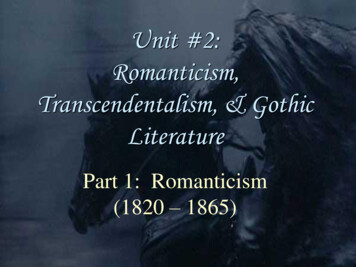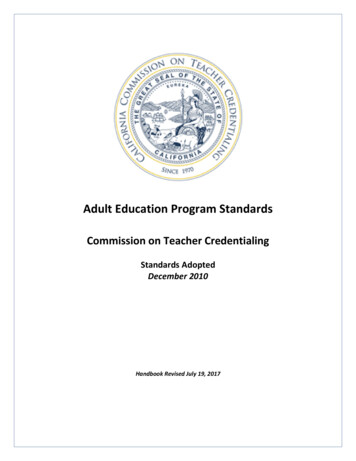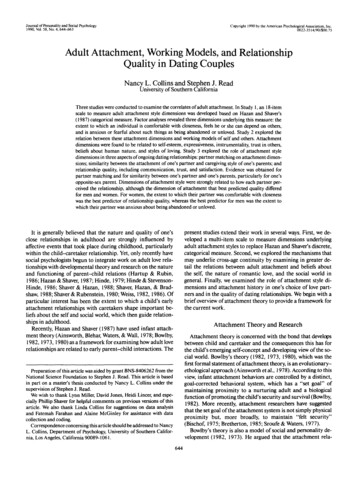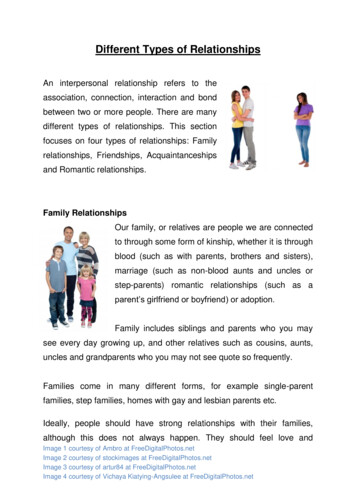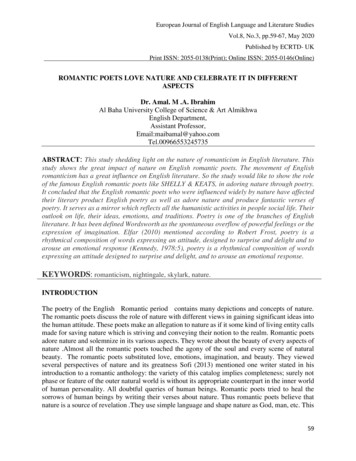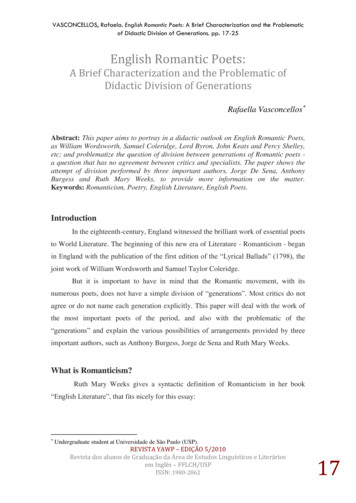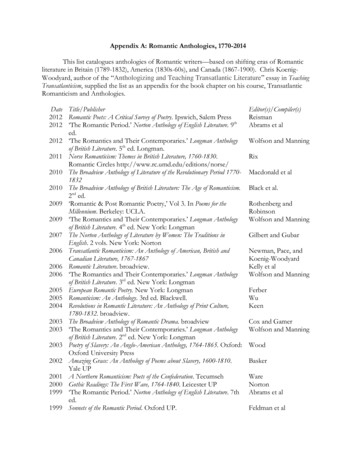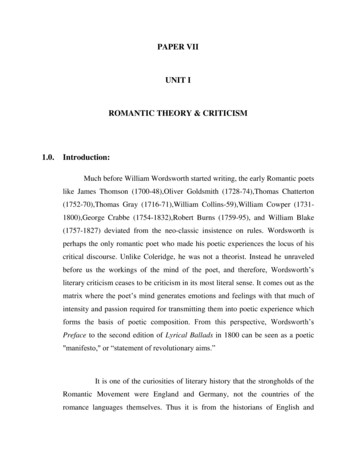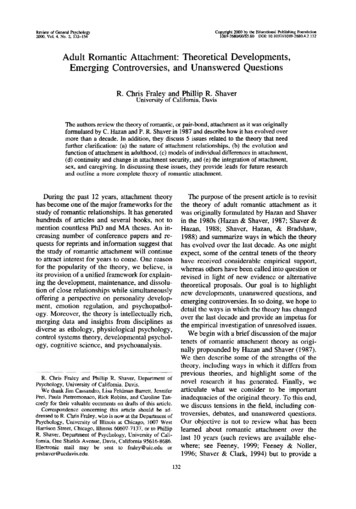
Transcription
Review of General Psychology2000, Vol. 4, No. 2, 132-154Copyright 2000 by the Educational Publishing Foundation1089-2680/00/ 5.00 DOI: 10.1037//1089-2680.4.2.132Adult Romantic Attachment: Theoretical Developments,Emerging Controversies, and Unanswered QuestionsR. Chris F r a l e y and Phillip R. S h a v e rUniversity of California, DavisThe authors review the theory of romantic, or pair-bond, attachment as it was originallyformulated by C. Hazan and P. R. Shaver in 1987 and describe how it has evolved overmore than a decade. In addition, they discuss 5 issues related to the theory that needfurther clarification: (a) the nature of attachment relationships, (b) the evolution andfunction of attachment in adulthood, (c) models of individual differences in attachment,(d) continuity and change in attachment security, and (e) the integration of attachment,sex, and caregiving. In discussing these issues, they provide leads for future researchand outline a more complete theory of romantic attachment.During the past 12 years, attachment theoryhas become one of the major frameworks for thestudy of romantic relationships. It has generatedhundreds of articles and several books, not tomention countless PhD and M A theses. An increasing number of conference papers and requests for reprints and information suggest thatthe study of romantic attachment will continueto attract interest for years to come. One reasonfor the popularity of the theory, we believe, isits provision of a unified framework for explaining the development, maintenance, and dissolution of close relationships while simultaneouslyoffering a perspective on personality development, emotion regulation, and psychopathology. Moreover, the theory is intellectually rich,merging data and insights from disciplines asdiverse as ethology, physiological psychology,control systems theory, developmental psychology, cognitive science, and psychoanalysis.R. Chris Fraley and Phillip R. Shaver, Department ofPsychology, University of California, Davis.We thank Jim Cassandro, Lisa Feldman Barrett, JenniferFrei, Paula Pietromonaco, Rick Robins, and Caroline Tancredy for their valuable comments on drafts of this article.Correspondence concerning this article should be addressed to R. Chris Fraley, who is now at the Department ofPsychology, University of Illinois at Chicago, 1007 WestHarrison Street, Chicago, Illinois 60607-7137, or to PhillipR. Shaver, Department of Psychology, University of California, One Shields Avenue, Davis, California 95616-8686.Electronic mail may be sent to fraley@uic.edu orprshaver@ucdavis.edu.The purpose of the present article is to revisitthe theory of adult romantic attachment as itwas originally formulated by Hazan and Shaverin the 1980s (Hazan & Shaver, 1987; Shaver &Hazan, 1988; Shaver, Hazan, & Bradshaw,1988) and summarize ways in which the theoryhas evolved over the last decade. As one mightexpect, some of the central tenets of the theoryhave received considerable empirical support,whereas others have been called into question orrevised in light of new evidence or alternativetheoretical proposals. Our goal is to highlightnew developments, unanswered questions, andemerging controversies. In so doing, we hope todetail the ways in which the theory has changedover the last decade and provide an impetus forthe empirical investigation of unresolved issues.We begin with a brief discussion of the majortenets of romantic attachment theory as originally propounded by Hazan and Shaver (1987).We then describe some of the strengths of thetheory, including ways in which it differs fromprevious theories, and highlight some of thenovel research it has generated. Finally, wearticulate what we consider to be importantinadequacies of the original theory. To this end,we discuss tensions in the field, including controversies, debates, and unanswered questions.Our objective is not to review what has beenlearned about romantic attachment over thelast 10 years (such reviews are available elsewhere; see Feeney, 1999; Feeney & Noller,1996; Shaver & Clark, 1994) but to provide a132
SPECIAL ISSUE: ATI'ACHMENT DEVELOPMENTS,CONTROVERSIES,AND QUESTIONSuseful guide to some of the issues that we believe need to be studied in the decade to come.A p p l i c a t i o n o f A t t a c h m e n t T h e o r y toAdult Romantic RelationshipsAlthough attachment theory was originallydesigned to explain the emotional bond betweeninfants and their caregivers, Bowlby (1979/1994) believed that attachment is an importantcomponent of human experience "from the cradle to the grave" (p. 129). He viewed attachment relationships as playing a powerful role inadults' emotional lives:Many of the most intense emotions arise during theformation, the maintenance, the disruption and therenewal of attachment relationships. The formation ofa bond is described as falling in love, maintaining abond as loving someone, and losing a partner as grieving over someone. Similarly, threat of loss arousesanxiety and actual loss gives rise to sorrow while eachof these situations is likely to arouse anger. The unchallenged maintenance of a bond is experienced as asource of security and the renewal of a bond as asource of joy. Because such emotions are usually areflection of the state of a person's affectional bonds,the psychology and psychopathology of emotion isfound to be in large part the psychology and psychopathology of affectional bonds. (Bowlby, 1980, p. 40)In the 1970s and early 1980s, several investigators began to use Bowlby's ideas as a framework for understanding the nature and etiologyof adult loneliness and love. Some researchershad noticed that many lonely adults report troubled childhood relationships with parents andeither distant or overly enmeshed relationshipswith romantic partners, suggesting that attachment history influences the frequency and formof adult loneliness (Rubenstein & Shaver, 1982;Shaver & Hazan, 1987; Weiss, 1973). Furthermore, social psychologists and anthropologistshad observed considerable variability in theway people approach love relationships (ranging from intense preoccupation to active avoidance) and were developing individual-differences taxonomies to characterize this variability(e.g., Lee's "love styles" [Hendrick & Hendrick, 1986; Lee, 1973, 1988] and Sternberg'scomponents of love [Sternberg, 1986]). Despitethese rich descriptions and taxonomies, therewas no compelling theoretical frameworkwithin which to explain the normative phenomena of love or to organize and explain the observed individual differences (Hazan & Shaver,1994).133To address this need for a theory, Hazan andShaver (1987) published an article in whichthey conceptualized romantic love, or pairbonding, as an attachment process, one thatfollows the same sequence of formative stepsand results in the same kinds of individual differences as infant-parent attachment. Althoughthe theory was originally spelled out in severalextensive papers (Hazan & Shaver, 1987;Shaver & Hazan, 1988; Shaver et al., 1988), thecentral propositions can be summarized briefly.1. The emotional and behavioral dynamics ofinfant-caregiver relationships and adult romantic relationships are governed by the samebiological system. According to Bowlby, infantattachment behavior is regulated by an innatemotivational system, the attachment behavioralsystem, "designed" by natural selection to promote safety and survival (Bowlby, 1969/1982;see also Insel, 2000). The internal dynamics ofthe attachment system are similar to those of ahomeostatic control system in which a "setgoal" is maintained by the constant monitoringof endogenous and exogenous signals and bycontinuous behavioral adjustment. In the case ofthe attachment system, the set goal is physicalor psychological proximity to a caregiver. Asillustrated in the top part of Figure 1, when achild perceives an attachment figure to benearby and responsive, he or she feels safe,secure, and confident and behaves in a generallyplayful, exploration-oriented, and sociable manner. When the child perceives a threat to therelationship or to the self (e.g., illness, fear, orseparation), however, he or she feels anxious orfrightened and seeks the attention and supportof the primary caregiver. Depending on the severity of the threat, these attachment behaviorsmay range from simple visual searching to intense emotional displays and vigorous activity(e.g., crying and insistent clinging). Attachmentbehavior is "terminated" by conditions indicative of safety, comfort, and security, such asreestablishing proximity to the caregiver.Hazan and Shaver observed that adult romantic relationships are characterized by dynamicssimilar to these. For example, adults typicallyfeel safer and more secure when their partner isnearby, accessible, and responsive. Under suchcircumstances, the partner may be used as a"secure base" from which to explore the environment (or engage in creative projects as partof leisure or work; Hazan & Shaver, 1990).
134FRALEY AND SHAVERPlayful, lessinhibited, smiling,sociableYesAttachment behaviors are Iactivated to some degree,ranging from simple visual Imonitoring to intenseprotest, clinging, andsearch ngIPlayful, lessinhibited, smiling,exploration-oriented,sociableYesAttachment behaviorsare activated to somedegree, ranging fromsimple visualmonitoring to intenseprotest, clinging, andsearchingInhibit emotionalexpression andattachment behaviorsIFigure 1.Top: Control-systems model of the rudimentary dynamics of the attachmentsystem. Bottom: Modified version of the model. According to this model, the attachmentsystem has two key components. The first is an appraisal component that detects and evaluatescues indicative of rejection or abandonment. The second is a behavioral selection componentresponsible for organizing behavior and attention with respect to avoidance-oriented goals orproximity-seeking goals.
SPECIAL ISSUE: ATTACHMENT--DEVELOPMENTS,CONTROVERSIES,AND QUESTIONSWhen an individual is feeling distressed, sick,or threatened, the partner is used as a source ofsafety, comfort, and protection. Hazan andShaver summarized other noteworthy parallelsbetween infant-mother relationships and adultromantic relationships. For example, both kindsof relationships involve periods of ventral-ventral contact, "baby talk," cooing, and sharing ofinteresting "discoveries" and experiences. Thus,the emotions and behaviors that characterizeromantic relationships and infant-parent relationships share similar activating and terminating conditions and appear to exhibit the samelatent dynamics (Shaver et al., 1988).2. The kinds of individual differences observed in infant-caregiver relationships aresimilar to the ones observed in romantic relationships. Specifically, Hazan and Shaver argued that the major patterns of attachment described by Ainsworth (secure, anxious-ambivalent, and anxious-avoidant) were conceptuallysimilar to the "love styles" observed amongadults by Lee and others (see Davis, Kirkpatrick, Levy, & O'Hearn, 1994). AlthoughBowlby and Ainsworth had mentioned the roleof attachment in adult romantic relationships,no one had actually attempted to assess andstudy, in the adult pair-bonding context, thekinds of individual differences described byAinsworth and her colleagues (Ainsworth, Blehar, Waters, & Wall, 1978).When Hazan and Shaver (1987) began theirwork on romantic attachment, they adoptedAinsworth's three-category scheme as a framework for organizing individual differences inthe way adults think, feel, and behave in romantic relationships. Specifically, they argued thatthree qualitatively distinct types of romantic, orpair-bond, attachment exist: secure, anxiousambivalent, and avoidant. In their initial studies,Hazan and Shaver (1987, 1990) developed briefmultisentence descriptions of each of the threeproposed attachment types as they were expected to be experienced by each kind of individual: "I am somewhat uncomfortable beingclose to others; I find it difficult to trust themcompletely, difficult to allow myself to dependon them. I am nervous when anyone gets tooclose, and often, others want me to be moreintimate than I feel comfortable being"(avoidant). "I find it relatively easy to get closeto others and am comfortable depending onthem and having them depend on me. I don't135worry about being abandoned or about someonegetting too close to me" (secure). "I find thatothers are reluctant to get as close as I wouldlike. I often worry that my partner doesn't reallylove me or won't want to stay with me. I wantto get very close to my partner, and this sometimesscares people away" (anxious-ambivalen0.These descriptions were based on a speculative extrapolation of the three infant patternssummarized in the final chapter of the book byAinsworth et al. (1978). Respondents wereasked to think back across their history of romantic relationships and indicate which of thethree descriptions best captured the way theygenerally experienced their romantic relationships. In their initial studies, Hazan and Shaver(1987) found that people's self-reported romantic attachment pattern was related to a numberof theoretically relevant variables, including beliefs about love and relationships and recollections of early experiences with parents.3. Individual differences in adult attachmentbehavior are reflections of the expectations andbeliefs people have formed about themselvesand their close relationships on the basis oftheir attachment histories; these "working models" are relatively stable and, as such, may bereflections of early caregiving experiences. Theworking models construct was rooted in theliterature on infant attachment (for reviews,see Bretherton & Munholland, 1999; Cassidy,2000). According to attachment theory, the degree of security an infant experiences during theearly months of life depends largely on exogenous signals, such as the proximate availabilityand responsiveness of primary caregivers. Overrepeated interactions, however, children are theorized to develop a set of knowledge structures,or internal working models, that represent thoseinteractions and contribute to the endogenousregulation of the attachment behavioral system.If significant others are generally warm, responsive, and consistently available, the child learnsthat others can be counted on when needed.Consequently, he or she is likely to explore theworld confidently, initiate warm and sociableinteractions with others, and find solace in theknowledge that the caregiver is potentiallyThese types are sometimes referred to as attachmentstyles, attachmentpatterns, or attachmentorientationsin theliterature on close relationships.
136FRALEY AND SHAVERavailable (Ainsworth et al., 1978). In short, thechild has developed secure working models ofattachment. If significant others are cold, rejecting, unpredictable, frightening, or insensitive,however, the child learns that others cannot becounted on for support and comfort, and thisknowledge is embodied in insecure or anxiousworking models of attachment. The insecurechild is likely to regulate his or her behavioraccordingly, either by excessively demandingattention and care or by withdrawing from others and attempting to achieve a high degree ofself-sufficiency (Main, 1990; for meta-analysesof the effects of maternal and paternal behavioron child security, see De Wolff & van IJzendoom, 1997; van IJzendoom, 1995; van IJzendoom & De Wolff, 1997).According to Hazan and Shaver (1987),working models of attachment continue toguide and shape close relationship behaviorthroughout life (for a review of the workingmodel concept in adult attachment, see Pietromonaco & Feldman Barrett, 2000). As people build new relationships, they rely partly onprevious expectations about how others arelikely to behave and feel toward them, and theyuse these models to interpret the goals or intentions of their partners. Working models are believed to be highly resistant to change becausethey are more likely to assimilate new relationalinformation, even at the cost of distorting it,than accommodate to information that is at oddswith existing expectations. In this respect, thetheory explains continuity in the way peoplerelate to others across different relationships.Moreover, the theory suggests that early caregiving experiences influence, at least in part,how people behave in their adult romantic relationships. As such, the theory provides a way topreserve an early psychoanalytic insight aboutadult relational patterns without introducingcontroversial psychoanalytic mechanisms, suchas regression or fixation.4. Romantic love, as commonly conceived,involves the interplay of attachment, caregiving, and sex. Although romantic love is partlyan attachment phenomenon, it involves additional behavioral systems, caregiving and sex,that are empirically intertwined with attachmentbut theoretically separable. In infancy, attachment behavior is adaptive only if someone (i.e.,a parent) is available to provide protection andsupport. Typically, a parent provides protectionand care to the infant. In adult relationships,however, these roles (attachment and caregiving) are more difficult to separate. Either partnercan be characterized at one time or another asstressed, threatened, or helpless and hence asneeding responsive, supportive care from theother. Similarly, either partner can be characterized at times as being more helpful, empathic, or protective. In a long-term relationship, the attachment and caregiving roles arefrequently interchanged.Sexuality is also of major importance in understanding romantic love. Although there aregood reasons to consider attachment and sexualbehavior as regulated by different systems, it isdifficult to deny that the two systems mutuallyinfluence each other. For example, a person mayforgo his or her sexual desires or needs whenfeeling distressed or anxious about the whereabouts of a long-term mate. Similarly, a personmay adopt sexual strategies (e.g., short-termmating strategies) that serve to inhibit the development of deep emotional attachments (i.e.,serve the function of intimacy avoidance anddependency avoidance).In sum, from Hazan and Shaver's perspective, romantic love can be understood in termsof the mutual functioning of three behavioralsystems: attachment, caregiving, and sex. Although each system serves a different functionand has a different developmental trajectory, thethree are likely to be organized within a givenindividual in a way that partly reflects experiences in attachment relationships.Strengths o f an Attachment-TheoreticalApproachOne strength of attachment theory is itsplacement of intimate relationships in an ethological framework. An ethological approachbroadens the nature of the questions asked abouta phenomenon, thereby making the answersmore comprehensive (Hinde, 1982). Many nonethological researchers are trained to ask highlycircumscribed questions about a behavior pattern, such as "What are the causal mechanismsunderlying this pattern?" or "How does thispattern develop?" Ethologists recognize at leasttwo other questions: questions concerning function (e.g., "What is this behavior for, and howdoes it contribute to survival or reproduction?")and evolution (e.g., "How did it evolve?").
SPECIAL ISSUE: ATFACHMENT--DEVELOPMENTS, CONTROVERSIES, AND QUESTIONSTaken together, these four questions--causation, development, function, and evolution-characterize the ethological approach to behavior (Tinbergen, 1963). 2As an illustration of the value of an ethological approach to relationships, consider the example of relationship dissolution due to loss orseparation. Separated or bereaved individualscontinue to yearn for and pine for their separated partners long after separation, sometimesfor years. They are particularly sensitive to perceptual cues related to their partner (e.g., readilymistaking a passerby for their lost partner) andhave a difficult time finding someone who canfill the gap left in their lives by the absence oftheir partner (see Parkes & Weiss, 1983). Theempirical literature on separation and loss hasfocused primarily on the various predictors ofsuch postdissolution distress. Doing so has ledto a number of interesting discoveries. For example, highly neurotic people tend to experience more distress after a loss than less neuroticpeople (Vachon et al., 1982). Social supportsometimes buffers the negative effects of loss(Stylianos & Vachon, 1993). However, in tryingto account for variation in postseparation distress, this line of inquiry has addressed questions about causal mechanisms only. An ethological approach, such as attachment theory,would also ask the following questions: Why doseparated partners experience anxiety? Dosearching and vigilance serve a function thatmight facilitate, or once have facilitated, survival or reproductive fitness? How do thesebehavioral and emotional reactions develop?How early in life can they be observed? Howdid these behaviors evolve? Are they present inother species, and do they serve similar functions in those species?A second advantage of the attachment-theoretical perspective on intimate relationships isthat, in addition to focusing on normative aspects of relational processes (Hazan & Shaver,1994), it draws attention to variability in theway people experience and behave in relationships. In fact, it is the individual-differencescomponent of the theory that has attracted themost research attention. Hazan and Shaver'sthree-category model of individual differenceshas been influential for at least three reasons.First, it provides a framework broad enough toaccount for the kinds of variability detailed byastute observers of human relational behavior137(e.g., Lee, 1973; Sternberg, 1986), including thecool aloofness exhibited by some people and theintense preoccupation with relationships exhibited by others. Second, the developmental assumptions of the model allow variation in infantand romantic attachments to be understoodwithin the same theoretical framework. Third,the model nicely incorporates the major assumptions of social psychology and personalitypsychology. That is, it postulates a set of mechanisms (i.e., working models) that contribute toindividual stability while recognizing the powerful influence of environmental factors on attachment behavior.Attachment theory's focus on individual differences has inspired many interesting studiesthat, we believe, would not have been generatedby alternative theoretical approaches to closerelationships. For example, researchers have examined the influence of working models on theinferences people make about their partner'sintentions (Collins, 1996); the interplay of distress and working models as determinants ofattachment and caregiving behavior (Fraley &Shaver, 1998; Simpson, Rholes, & Nelligan,1992); the role of working models in partnerpreferences (Chappell & Davis, 1998; Frazier,Byer, Fischer, Wright, & DeBord, 1996; Pietromonaco & Carnelley, 1994), relationshipstability (Kirkpatrick & Davis, 1994; Kirkpatrick & Hazan, 1994), and relationship dissolution (Feeney & Noller, 1992; Pistole, 1995;Simpson, 1990); and the psychodynamic organization and functioning of working models(Bartholomew, 1990; Fraley, Davis, & Shaver,1998; Fraley & Shaver, 1997; Mikulincer,1998; Mikulincer, Florian, & Tolmacz, 1990;Mikulincer & Orbach, 1995).Theoretical Developments, EmergingControversies, and Unanswered QuestionsDespite the strengths of the attachment-theoretical perspective, its 1980s formulation suffersfrom a number of limitations. For example, thetheory contained an implicit assumption that all2 Ethology is sometimes narrowly defined as the study ofanimals in their natural environments. Although it is truethat some ethologists study animals in their natural environments, the field is better characterized by its focus on thebiological study of behavior, wherein biology is conceptualized more broadly than physiology.
138FRALEY AND SHAVERromantic relationships are attachment relationships, and it therefore failed to provide a meansof separating attachment from nonattachmentrelationships. It also failed to provide a clearaccount of the evolution and function of attachment in romantic relationships. In addition,since 1987 several theoretical and empirical developments have challenged parts of Hazan andShaver's formulation of romantic, or pair-bond,attachment theory. Our objective in this sectionis to make these controversies and unansweredquestions explicit and suggest how they mightbe resolved.What Is an Attachment Relationship ?In the literature on infant-parent attachment,it is generally assumed that all children areattached to their primary caregivers (Cassidy,1999). Individual differences in attachment arethought to reflect differences in the quality ofthe relationship, not differences in the degree ofattachment or the presence or absence of attachment per se. In the context of adult relationships, however, it is not necessarily the case thatromantic partners are attached to each other.Although it is frequently assumed in the literature on romantic attachment that relationshipsbeyond some arbitrary length are attachmentrelationships, this assumption is rarely tested. Itis critical to do so because there are good reasons to believe that the kinds of processes studied by attachment researchers are a function notonly of attachment style but also of whether therelationship serves attachment-related functionsfor the individuals involved (see Fraley &Davis, 1997; Fraley & Shaver, 1999). Also, inexploring the role of attachment in other kindsof relationships (e.g., friendships, sibling relationships, attachments to teachers or nurses, andspiritual relationships), it is necessary to have atheoretically defensible way to establish or qualify the nature of the bond under investigation.Attachment theorists have proposed a varietyof features that distinguish attachment relationships from other kinds of relationships (Ainsworth, 1982, 1991; Hazan & Zeifman, 1994;Weiss, 1982, 1991). Three functions or featuresreappear in various taxonomies. First, an attachment bond is marked by the tendency for anindividual to remain in close contact with theattachment figure. That is, the attachment figureis used as a target of proximity maintenance,and separations, when they occur, are temporaryand typically met with some degree of distressor protest. Second, an attachment figure is usedas a safe haven during times of illness, danger,or threat. In other words, the attached individualuses the attachment figure as a haven of safety,protection, and support. Third, an attachmentfigure is relied on as a secure base for exploration. The presence of the attachment figurepromotes feelings of security and confidence,thereby facilitating uninhibited and undistractedexploration.Researchers have used these features to differentiate attachment from nonattachment relationships in adulthood. Hazan and her colleagues (Hazan, Hutt, Sturgeon, & Bricker,1991) created self-report and interview methodsfor identifying a person's attachment figures.These methods instruct people to nominate oneor more individuals whom they use as (a) atarget for proximity maintenance, (b) a safehaven, and (c) a secure base. According toHazan et al.'s cross-sectional research, childrenprimarily nominate their parents for these rolesor functions, but adolescents and adults tend tonominate their peers (close friends or romanticpartners). According to Hazan et al.'s model,the three functions are serially transferred fromone attachment figure, or set of attachment figures, to another, with proximity maintenancebeing transferred first, followed by safe havenand, finally, secure base. This pattem of transfercorresponds to the stages of attachment development that Ainsworth (1972; elaborating onBowlby, 1969/1982, pp. 265-268) called "preattachment," "attachment in the making," and"clear-cut attachment." The best candidate for atrue attachment relationship is one in which allthree functions are present.Fraley and Davis (1997) modified the instruments used by Hazan et al. to study the extent towhich young adults had transferred each of theattachment-related functions from parents to romantic partners. In a sample of young adults,Fraley and Davis found that people who hadtransferred more of these functions to theirpeers (friends or romantic partners) had peerrelationships characterized by more caring,trust, and intimacy. Also, consistent with Hazanet al.'s findings, romantic attachments took approximately 2 years, on average, to develop,and secure individuals were more likely than
S,AND QUESTIONSinsecure individuals to use their romantic partners as attachment figures.Although these studies are reasonable initialattempts to differentiate attachment relationships from other kinds of emotional relationships in adulthood, the measures used are limited in a number of respects. First, as Trinke andBartholomew (1997) observed, some individuals are inclined to use their partners as a safehaven during times of distress but do not necessarily act on this inclination. To the extentthat this is the case, asking people whom theyactually use as a safe haven, for example, maylead to inaccurate inferences about their attachment dynamics. In an attempt to deal with thisproblem, Trinke and Bartholomew developed aself-report instrument that asks people whomthey would like to use, as well as whom theyactually do use, as a safe haven and secure base.A second potential concern with existing research on this topic is that the instruments usedby Hazan et al. (1991), Fraley and Davis (1997),and Trinke and Bartholomew (1997) led to theconclusion that secure individuals are morelikely to use their relationship partners as attachment figures. Although this finding is likelyto reflect something real about the nature ofattachment relationships (i.e., peop
Adult Romantic Attachment: Theoretical Developments, Emerging Controversies, and Unanswered Questions R. Chris Fraley and Phillip R. Shaver University of California, Davis The authors review the theory of romantic, or pair-bond, attachment as it was originally formulated by C. Hazan and P. R
